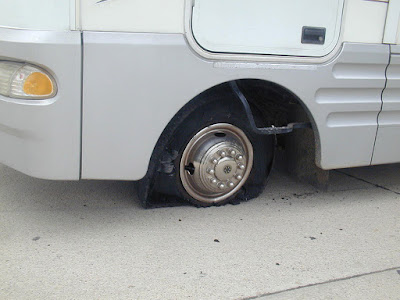A tire blowout is the worst fear of many RVers. What would you do if you found yourself in this situation? Read FMCA’s tips to stay safe on the road.
Understanding Tire Failure
According to Goodyear engineers, obstructions (nails, sharp objects, curbing) are the major causes of tire damage. However, many tire failures are caused by progressive damage.
Each mile your tire rolls down the highway overloaded or underinflated, it may be suffering internal damage that’s not apparent during a casual tire inspection. The day that the tire fails, you may be traveling empty or not moving at all. The tire simply will reach the point where the damage has exceeded its design limits. It may blow out or shed its tread.
Tires do not heal themselves, so if they are damaged due to underinflation, inflating them to the correct pressure may not prevent eventual failure.
What To Do If Your Tires Fail
If you experience a tire blowout, you better have your seat belt on because it can be a wild and bumpy ride.
Your natural reaction is to apply the brakes, but don’t do it! Michelin Tire Company recommends briefly pushing the accelerator to the floor (if traffic conditions allow) to regain momentum in the direction you are going and then gently taking your foot off the accelerator. Hold the steering wheel firmly and regain control. If you are on an expressway, move into the far right lane as quickly and safely as possible. Allow your vehicle to slow, without applying the brakes, to 10 to 15 MPH before pulling off the road surface.
Watch this video from Michelin, How To Handle An RV Tire Blowout.
And — remember — the #1 tip if you find yourself in the middle of a tire blowout is to remain calm. You can’t predict the future, but you CAN prepare yourself for potential emergencies. Knowledge is power.
FMCA RV Club brings you this monthly tip to Enhance Your RV Lifestyle. FMCA delivers RV know-how to its members. Join today for just $50 — a savings of $10 just for RV Trader readers. Learn more at https://join.fmca.com/trader18/.





